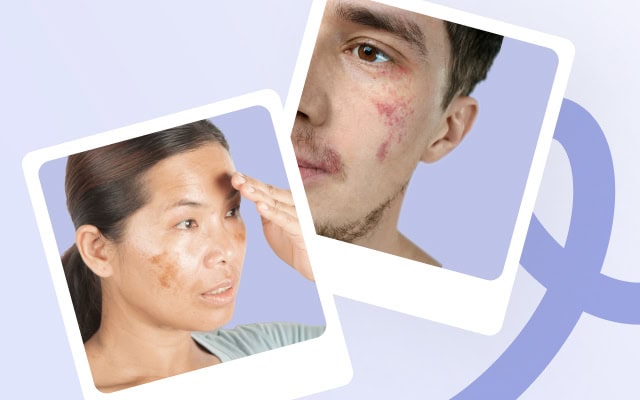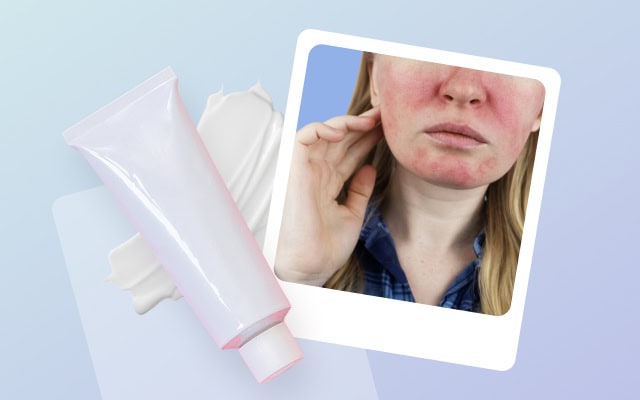How to get rid of rosacea permanently? We asked a board-certified dermatologist
Unfortunately, it is not possible to get rid of rosacea permanently, but you can learn how to keep your rosacea symptoms at bay with adequate treatment and advice from a board-certified dermatologist.
Table of Content:
What is rosacea? | How to get rid of rosacea? | Best rosacea treatment | How to get treatment? | How long do flare-ups last?
Our commitment to producing high-quality content:
The information presented in this article is based on scientific research and the professional advice of our Content Medical Reviewers, who are experts in the field of Dermatology. How we write our content →
What is rosacea?
Rosacea is a common skin condition that primarily affects the face. It is characterized by redness, flushing, visible blood vessels, small red bumps (papules), small pus-filled lesions (pustules), , and sometimes thickening of the skin, especially around the nose, but it can also affect the eyes. It often occurs in middle-aged individuals with fair skin, blue eyes, and blonde hair, but it can affect people of any skin type1.
There are four distinct types of rosacea, each characterized by specific symptoms: erythematotelangiectatic rosacea (redness), papulopustular rosacea (red bumps and pustules), phymatous rosacea (skin thickening), and ocular rosacea (eye redness and irritation).
Do you need a prescription for rosacea?
There are some creams for rosacea available over the counter. However, if you have used those and you have not obtained the results you have hoped for, then you should consult a dermatologist to get prescription-strength treatment creams.
How can I get rosacea treatment fast?
You can use Miiskin to have a photo-consultation with an online dermatologist. After 1-2 days you will get your prescription. the consultation costs $59 and you need to purchase your medication separately at the local pharmacy.
So, how to get rid of rosacea permanently?
According to Dr. Alpana Mohta, board-certified dermatologist, since rosacea is a chronic condition, you cannot get rid of it permanently. However, it is important to understand that the severity of your symptoms will vary over time depending on different factors and that with the right treatment, you can effectively keep your symptoms at bay.
If you suspect you have rosacea, you can consult an online dermatologist to get a proper diagnosis and personalized treatment.
What is the best rosacea treatment?
According to Dr. Mohta, since the symptoms and severity of the condition will greatly vary from person to person, there isn’t a one-size fits all treatment. Getting a customized formula for rosacea may be the best course of action because treatment often involves a combination of topical and/or oral medications, lifestyle changes, and a skincare routine tailored to your type and symptoms.
Medications used for the treatment of rosacea
Topical alpha-adrenergic agonists
Topical alpha-adrenergic agonists (such as oxymetazoline hydrochloride and brimonidine) are medications often used in dermatology to constrict blood vessels, and reduce facial redness and flushing associated with rosacea2.
Ivermectin cream
Ivermectin cream (sold under the brand name Soolantra) is approved for the treatment of inflammatory lesions in papulopustular rosacea. It has anti-inflammatory and anti-parasitic properties but it is not an antibiotic, reducing concerns related to antibiotic resistance. Topical ivermectin is used for the treatment of inflammatory papules and pustules of moderate to severe rosacea3.
Azelaic acid
Azelaic acid is a topical prescription medicine used to treat papules and pustules in mild to moderate rosacea4. It is available by prescription in foam and gel preparations in a 10-20% formulations.
Topical antibiotics
Topical antibiotics such as metronidazole5 and clindamycin6 are often a first-line treatment for mild to moderate papulopustular rosacea.
Tetracycline-class antibiotics
For moderate to severe rosacea, dermatologists may prescribe low-dose oral antibiotics (such as doxycycline, minocycline, or tetracycline). These medications can provide a systemic control of inflammation and redness7.
Encapsulated benzoyl peroxide cream
Encapsulated benzoyl peroxide is a novel topical medication used to treat the inflammatory papules and pustules of mild to moderate rosacea. Even though benzoyl peroxide often dries skin with rosacea, the encapsulation allows the medicine to be effective without irritating the skin8.
Sodium sulfacetamide and sulfur topical cream
The combination of sodium sulfacetamide and sulfur as a topical medication has proved to be effective in the treatment of rosacea as well as acne and seborrheic dermatitis and it is generally well-tolerated by patients9.
Accutane (isotretinoin)
In severe cases of rosacea or when other treatments are ineffective, your dermatologist may recommend Accutane (isotretinoin)10.
Does tretinoin work for rosacea?
Tretinoin is not really used in the treatment of rosacea. However, you can still use tretinoin, even if you have rosacea, once your symptoms are gone.
How long does it take to get rid of a rosacea flare-up?
Getting rid of a rosacea flare up can take between one week to up to several weeks (or even months) depending on the severity of the flare up, how well you follow the advice given by your dermatologist, and how your skin reacts to the treatment.
How can I get medicine for rosacea?
You can have a virtual photo consultation with a dermatologist. All you need to do is take some photos and answer some questions. The dermatologist will get back to you 1-2 days later and you will get your prescription.
Lee este artículo en Español ¿Qué es la rosácea y cuál es el mejor tratamiento?
Rosacea articles reviewed by dermatologists
How to calm a rosacea flare-up?
Does metronidazole work for rosacea?
Can you use tretinoin for rosacea?
Does Ivermectin work for rosacea?
Article References:
https://www.ncbi.nlm.nih.gov/pmc/articles/PMC5134688/
https://www.ncbi.nlm.nih.gov/pmc/articles/PMC5833911/
https://www.ncbi.nlm.nih.gov/pmc/articles/PMC4665052/
https://www.ncbi.nlm.nih.gov/pmc/articles/PMC8570659/
https://www.ncbi.nlm.nih.gov/pmc/articles/PMC10452484/
https://pubmed.ncbi.nlm.nih.gov/19271381/
https://www.ncbi.nlm.nih.gov/pmc/articles/PMC3175801/






 Get a rosacea prescription!
Get a rosacea prescription!